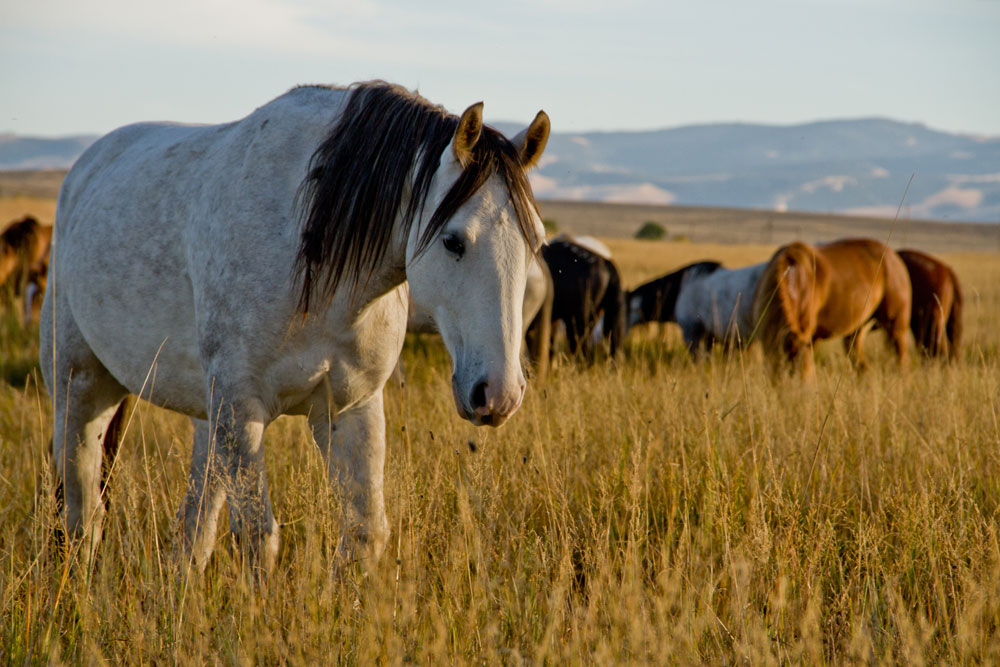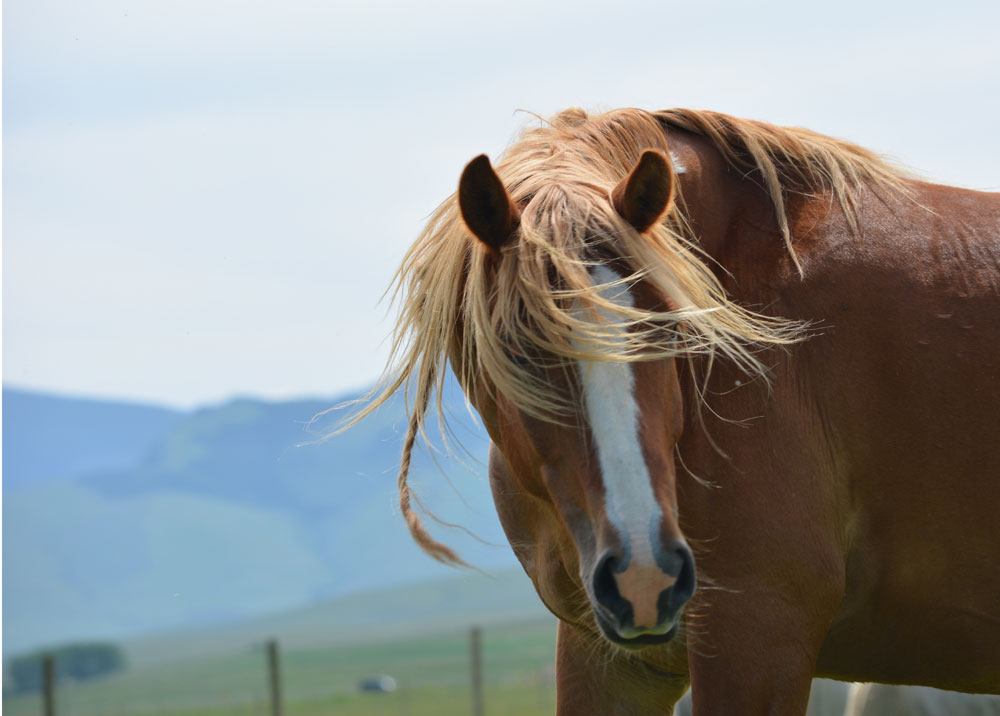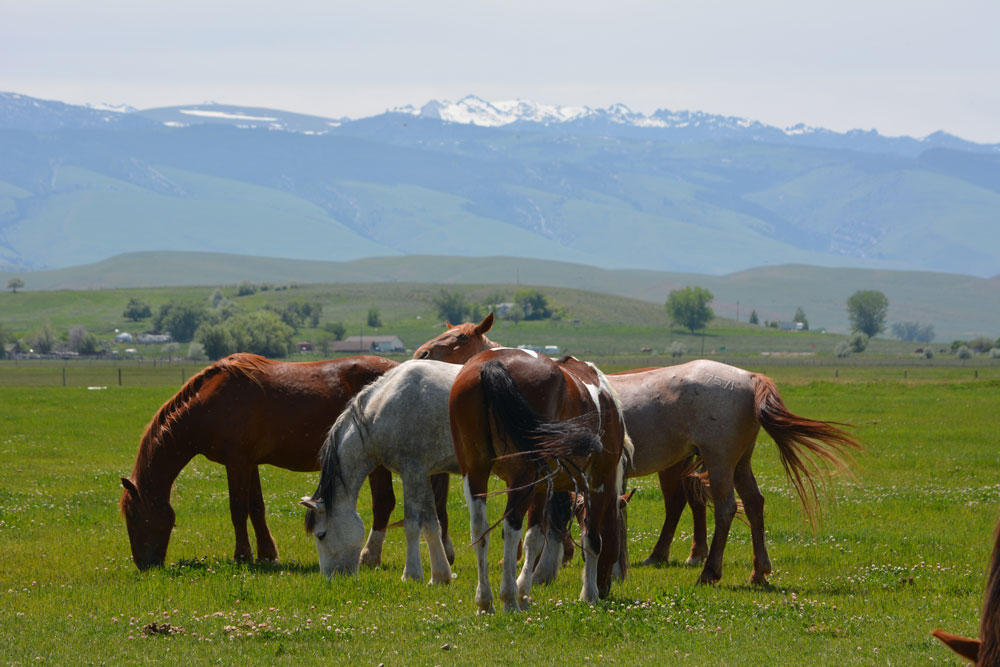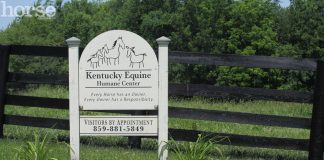
A herd of horses fluffy with winter coats munch on hay while they eye us curiously as we circle the pasture in a utility vehicle at Wind River Wild Horse Sanctuary. “That one’s Thor,” says Odessa Oldham, pointing through the falling snow at a chestnut with a lightning-strike blaze. Thor lifts his head and looks at us. His unruly mane signals lingering wildness, but his lazy expression reminds me that this land is his permanent home, and he’s getting used to the occasional ogling human.
Fate of the Mustangs
With tens of thousands of horses on public lands in the American west, the BLM is tasked with the Sisyphean responsibility of managing them in balance with environmental, agricultural, and extraction interests. Each year, the agency rounds up thousands of Mustangs and hundreds of wild burros from rangeland throughout the region.
About three-quarters get adopted, either directly off the range or after training stints with volunteers, non-profits, or in state and county detention programs. Currently 44,515 Mustangs live off-range, 636 of them at eco-sanctuaries like Wind River.
Eco-sanctuaries fall under the BLM’s permanent or long-term facilities that house unadoptable horses. But, unlike their counterparts, the eco-sanctuaries are open to the public and must include an element of education.
It’s this teaching component that drew the Oldhams to the project in the first place. Though eco-sanctuaries don’t hold a lot of horses—Wind River Wild Horse Sanctuary currently has 146—they have a unique opportunity to raise awareness about wild horses. The Oldhams draw on their own Native American roots as well as their position on the 2.2-million-acre Wind River Indian Reservation, which is home to Northern Arapaho and Eastern Shoshone people.
“We wanted to be part of the solution. Instead of just housing, we’re educating,” says Dwayne. “We’re talking about the [wild horse] issue, and we’re talking about its history with the tribes.”
Anthropologists have referred to the years 1640 to 1880 as the period of the Indian horse culture. As the tribes inhabiting the continent’s sprawling plains learned to harness the power and speed of equines for themselves, their societies changed. Horses increased hunters’ success rates, made nomadic movement easier, and upped warriors’ defensive and offensive prowess.
Over time, some tribes changed their myths and lore to incorporate horses. In a few cases, as with the emergence of the Eastern Shoshone, multiple tribes merged under a single umbrella because horses were fundamental to all of their lives.

Guided Tours
To share this history with the public, the Oldhams guide tours of the sanctuary and host special events that showcase both Native American and ranching life. Sitting about 10 minutes north of Lander, Wyo., on the road to Yellowstone National Park, the Wind River Wild Horse Sanctuary makes an appealing stop on a summer road trip.
At the facility’s entrance, a small but mighty visitor’s center highlights the significance of the horse to Native American cultures past and present. There, guests can delve into history, reading about the time Lewis and Clark bought expedition horses from the Eastern Shoshone.
Those looking for a more contemporary lens on the bond between horses and Native Americans can learn about the Indian rodeos and Indian relay races that take place throughout the West each summer. A small gift shop offers souvenirs, Native American jewelry, and photos of the sanctuary’s four-legged residents.
To ensure their relationship with local tribes is one of respect, the Oldhams have invited tribal leaders to the sanctuary and strive to give back to the reservation economy by hiring Native Americans and purchasing hay and leasing land from members.
But for the Oldhams, the Wind River Wild Horse Sanctuary has a purpose that extends beyond bringing in tourists. Odessa was the first Native American to hold an officer position in Future Farmers of America, and is an ardent advocate for improving agricultural education for Native Americans. At the sanctuary, she facilitates youth programs, hosting students from the reservation and the town of Lander year-round for field trips that bring state history to life.

The Horses
Most of the horses at the Wind River Wild Horse Sanctuary come from Wyoming. Averaging 5 to 6 years of age, they are sturdy, good-looking animals that for various reasons—from insufficient demand to behavioral problems—never found homes.
At Wind River Wild Horse Sanctuary, they have landed somewhere safe, where they can graze in the shadow of the same Rocky Mountains where so many of their ancestors shaped human history.
According to Hope Ryden, author of America’s Last Wild Horses, most Native Americans acquired trained mounts through the extensive trade networks that flanked the Rockies rather than capturing unbroke steeds from the bands of Mustangs that roamed free.
These horses then lived semi-wild on the land, and if they escaped to form or join wandering bands of wild equines, they were rarely chased down. Unhindered by threat of capture, and pulling domesticated horses into their ranks, the herds swelled for generations.
Fittingly, Ryden says, North America’s wild horses might not even exist today if the Plains Indians had not been willing and able to change their own societies to incorporate them.
This article originally appeared in the May 2018 issue of Horse Illustrated magazine. Click here to subscribe!





